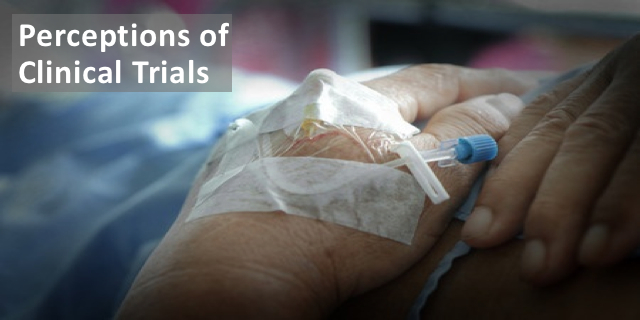Please take this short survey on Clinical Trials…then read on!
Surveys on Perceptions of Clinical Trials
If you are like most people, you may not have a very positive opinion of clinical trials. At least that is what a recent survey conducted by MaPS/Millward Brown Analytic and Memorial Sloan Kettering (MSKCC) suggests. Only 40% of those surveyed had “a positive overall impression of clinical trials.”
In another 2015 survey of over 12,000 people worldwide, around 20% felt they were “not at all or not very informed” about the term “clinical research.”
These figures may help to explain the fact that participation in clinical trials in the US is very low. In the almost 11,000 clinical trials that were enrolling 2.8 million participants altogether in 2009, 27% failed to enroll anyone. In cancer clinical trials—less than 5% of adults with cancer take part in them.
So what’s going on?
What Are Clinical Trials?
Clinical trials are research studies in which people volunteer to participate. They are the only accepted strategy to determine if treatments work, how safe they are, how reliable they are, and if one treatment is better than another. Most of the treatments being used today in oncology and other fields went through clinical trial research.
What are the protections for participants?
To protect volunteers, regulations and codes of conduct have evolved over time. Voluntary and informed consent is required. Prior to starting a study, Institutional Review Boards (IRB) review the study design to assure that volunteers are protected. There are also monitoring groups, not associated with the researchers conducting the study, who ensure the safety of participants.
Phases of Clinical Trials
In the US, the FDA regulates development and marketing of medications and treatments. There are many steps in the process of drug development.
Discovery
 Searching for new treatments for illnesses, like cancer or diabetes, is ongoing in universities, institutes and companies. The first steps in the process involve basic research; trying to understand the mechanisms that are causing the disease. Then researchers try to find ways to intervene. This is done with cells in test tubes. In the case of cancer, treatment are tested on cancer cells in lab dishes or test tubes. If a strategy is promising, research begins with animals, like mice, which have the cancer. The purpose is to get an idea as to the safety and effectiveness. It takes, on average, around 6 years to get to the point where a cancer drug can be tested on humans.
Searching for new treatments for illnesses, like cancer or diabetes, is ongoing in universities, institutes and companies. The first steps in the process involve basic research; trying to understand the mechanisms that are causing the disease. Then researchers try to find ways to intervene. This is done with cells in test tubes. In the case of cancer, treatment are tested on cancer cells in lab dishes or test tubes. If a strategy is promising, research begins with animals, like mice, which have the cancer. The purpose is to get an idea as to the safety and effectiveness. It takes, on average, around 6 years to get to the point where a cancer drug can be tested on humans.
FDA’s IND application
Before a medication can be tested on humans, the FDA reviews all the pre-clinical research. The FDA also want information on manufacturing, specifically to be sure of the quality of the medication and the ability of the company to produce the same product consistently. The FDA looks at IRB information, how the clinical trial studies will be conducted and the qualifications of those who will conduct the research.
If the IND application is approved, the drug has to go through at least 3 phases of testing. It takes on average around 8 years to make it through this testing.
Phase 1 Clinical Trials
These first trials are small with only about 15 to 30 volunteers involved. This phase asks the questions: How safe is this medication? What is a safe dosage? How should the medication be taken by the patient (pill form, IV, liquid?) What is the side effects?
Phase 2 Clinical Trials
During this phase less than 100 people are usually involved. It’s purpose is to determine what the effect of the medication is on the disease in humans.
 Phase 3 Clinical Trials
Phase 3 Clinical Trials
During phase 3, the treatment is compared with the standard treatment. These are randomized controlled trials in which some volunteers receive the experimental medication while others continue to take the current standard treatment. Placebos: that is, no treatment, is not part of this strategy. Larger numbers of people are needed in these studies, from 100 to thousands.
Why Don’t More People Participate In Clinical Trials?
One analysis, conducted in 2006, looked at barriers to participation described in over 20 studies involving 6000 cancer patients. These barriers included fear of possible negative changes in patient quality of life and worry that they would be receiving a placebo. Patients were also troubled by the possibility of side effects and concerned that the new treatment might not be the best course for their care.
The recent MSKCC survey found similar fears. Fifty-five percent thought that the top barrier to participation was anxiety over side effects and safety and 46% named worry over the possibility of getting a placebo as the top barrier. Another barrier was uncertainty about health insurance covering clinical trials. Others felt that travel to trial locations presented an obstacle to participation in clinical trials. Over 1/3 believed an impediment to participation was the feeling that they were like guinea pigs.
In the CISCRP 2015 survey, the most frequently mentioned barrier for people who said that they would not participate in clinic research was that they would not want to take a chance with their health. The survey confirms other research that people worry over the risks associated with clinical trials.
Physicians and Enrollment in Clinical Trials
The 2006 summary above found that the opinion and influence of the patient’s physician was the most instrumental factor in whether or not a patient would enroll in a clinical trial. The recent MSKCC survey included 594 practicing physicians specializing in oncology/hematology, OB/GYN, gastroenterology, urology, ear, nose and throat medicine, neurology, pulmonology, or dermatology. All of these physicians had discussed participation in clinical trials with patients.
Unfortunately, the surveyed physicians had some misconceptions. For example, most thought of clinical trials as a last resort for their patients or something to be utilized later rather than early in treatment.
The Bottom Line
According to information specialists at the National Cancer Institute’s Cancer Information Service, 1 in 5 adult cancer trials aren’t finished because they lack volunteers, not because there is a problem with the treatment.
If behooves us all to become educated about clinical trials. Although this post has focused on cancer clinical trials, there are opportunities to be a part of cutting edge research (and care) in studies on diabetes, rheumatoid arthritis and other conditions.
What are your thoughts on clinical trial participation? Are you interested in participating in clinical trials? Would you be more interested in clinical trials if your physician recommended them? Thank you for completing the survey. In a future post, we will share the results.






Cancer has destroyed my maternal family. If by participating in a clinical trial would eventually save a life, I would do it. Even if it would not benefit me personally, it would be worth the risk
I would do whatever it took to help all of us out and generations ahead. It’s so important to help in these studies so they can learn I’m a vet tech and I know how many break throughs have happened just in veterinary studies.
My husband is in an immunotherapy clinical trail..yes it’s time consuming ..he’s stage 4 colon cancer regarding chemo failed..this may be his only chance and he feels great so far…and he may help to save a few lives in the process
I posted positive as I know there are better treatments out there we’ve got to move them to actual use as fast as we can. I would really like it to be my Dr to recommend a trial but in some cases they do not have the time or have a specific dept in CCI for inquiries.
Before I was diagnosed, the breast surgeon offered me the opportunity to be screened for a trial (involving a neo-adjuvant angiogenesis inhibitor, IIRC). Unfortunately, the core needle biopsy came back negative, and she immediately scheduled me for an excisional biopsy. (She knew by looking at the ultrasound that it was cancer.)
Afterward, I pleaded with my medical onc for a clinical trial. She had absolutely no interest.
After it was (mostly) over–bilateral mastectomies, chemo, monoclonal antibody and radiation–I found the trial seeking to determine if metformin will prevent cancer recurrence, and I immediately enrolled.
I’m also enrolled in other studies.
The problem is that I had to find all these on my own because my doctors are not helpful. I’ve talked to patients whose doctors flat-out tell them they do not recommend trials because they want their patients to have proven treatments.
Clinical trials have a tough row to hoe to meet enrollment thresholds, but we will never get closer to better treatments if patients do not participate.
We may not be able to save our own lives, but we can leave behind a legacy of making future lives better. This is especially compelling for those of us who have children and grandchildren.
Thank you so much for sharing your experience here. Thank you also for participating in clinical trials, being an advocate and leaving a legacy for all of us. Kathleen
I think clinical trials are important in the advancement of medical treatments, but I would be concerned that I would be the volunteer who received the top unsafe dose of the drug…
The information was really helpful. it’s really informative and and covers all the aspects. There is also a lot of valuable information on this site for others who want to check it out. I want to encourage yourself to continue your great writing, have a nice day!
Thank you for sharing this amazing piece of content on clinical trials…